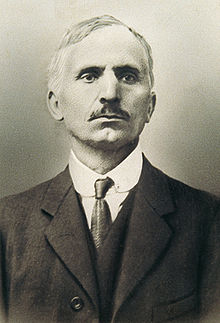Marius Borgeaud
| Marius Borgeaud | |
|---|---|

Marius Borgeaud in Paris, 1919
|
|
| Born | Lausanne |
| Died | Paris |
| Nationality | Swiss |
Marius Borgeaud (21 September 1861 – 16 July 1924) was a Swiss Post-Impressionist painter. He was born in Lausanne.
Borgeaud came from a bourgeois milieu; he attended the Industrial School of Lausanne and did not intend to pursue painting. As chance would have it, the future gallerist Paul Vallotton was one of his school-mates. In 1888, he began working in a bank in Marseille and remained there until the death of his father the following year. He inherited a significant legacy. The following decade saw Borgeaud squander that legacy by leading an expensive life, particularly in Paris. His excessive lifestyle threatened his health and forced him to detox on the shores of Lake Constance in 1900 under guardianship. Shortly after he returned to settle in Paris was when he devoted himself to painting.
His arrival in Paris, aspiring to become a painter at the turn of the twentieth century, was not out of the ordinary. The Swiss art colony there was healthy; some of its famous members were Félix Vallotton, Théophile Alexandre Steinlen, Eugene Grasset, Ernest Bieler, and René Auberjonois. After he became well-integrated among them around 1906, Borgeaud joined the Paris section of the Society of Painters and Swiss Architects.
His apprenticeship, between 1901 and 1903, was under the artists Fernand Cormon and Ferdinand Humbert, each of whom had a famous academy. Borgeaud's work from this era is mostly lost, and there are no known canvases before 1904.
Arriving late in the trade, at the age of forty, he frequently called on artists younger than himself. Some of them become friends such as Francis Picabia, Paul de Castro (1882–1939), Maurice Asselin (1882–1947) and especially Morerod Edward (1879–1919). For several summers, in 1904 or 1905, he painted with Picabia at Moret-sur-Loing (Seine-et-Marne) with brothers Ludovic Rodo Pissarro and Georges Manzana-Pissarro. The works of this period are strongly influenced by Impressionism. From these beginnings, only a dozen paintings have survived, mostly landscapes.
...
Wikipedia
